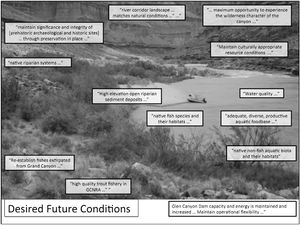|
These CRE DFCs address the natural resource values for which the GCNP and the GCNRA were established. The DFCs aim to comply with the GCPA and describe the individual resource objectives sought with the realization that they may not be achievable in the process of finding the most desirable mix of resources in the CRE and the natural habitats, and natural ecosystem processes. Native and non-native species are to be managed in accord with Federal regulations, policies, and guidelines. The CRE described herein includes most of the native natural resources found in the Colorado River. Those resources are managed, consistent with the “Law of the River” (described in part in Section 1802(b) of the GCPA”, under the National Park Service (NPS) Organic Act, the Redwoods Amendment, NPS 2006 Management Policies, the Wilderness Act, the Antiquities Act, the Endangered Species Act, the Grand Canyon Protection Act, the Fish and Wildlife Coordination Act, and other Federal legislation. The health of the river ecosystem and the protection of the resource values of GCNP and GCNRA are important to the nation, many Native American Tribes, the economy of the Southwest, and the millions of visitors to the parks and the region.
The CRE DFCs will provide a foundation for and help define the components of the Core Monitoring Program under development by the Grand Canyon Monitoring and Research Center (GCMRC). The Core Monitoring Program will be essential to ultimately quantifying, measuring, and reporting the status of the natural resources, allowing the Secretary and the AMP to track progress toward desired outcomes. DFCs will also provide foundation support in the development of other planning and management assignments associated with the GCDAMP.
|
|
These DFCs are intended to guide the gathering and analysis of data pertinent to the CRE in Grand Canyon National Park and Glen Canyon National Recreation Area. The CRE DFCs and the related documents will be used to provide direction towards development of the core monitoring program under development by the Grand Canyon Monitoring and Research Center (GCMRC). Through diligent and consistent monitoring, GCMRC may inform the Secretary as to whether as to what degree these DFCs are being achieved.
• Percentage of critical habitat lost or gained
• Condition of species variability (native population, abundance, distribution)
• Carrying capacity thresholds
• Population estimates
Sediment-related Resources
High elevation open riparian sediment deposits along the Colorado River in sufficient volume, area, and distribution so as to provide habitat to sustain native biota and desired ecosystem processes
• Nearshore habitats for native fish
• Marsh and riparian habitat for fish (food chain maintenance)
• Cultural resource preservation
• Maintenance of camping beaches
Water Quality
Water quality with regards to dissolved oxygen, nutrient concentrations and cycling, turbidity, temperature, etc., is sufficient to support natural ecosystem functions, visitor safety and visitor experience to the extent feasible and consistent with the life history requirements of focal aquatic species
• Ecosystem-sustaining nutrient distribution, flux, and cycling.
• Hydro-physical conditions and characteristics of the CRE necessary to sustain aquatic biota.
• Acceptable water quality for human health and visitor experience.
CRE Aquatic Domain
The aquatic food base will sustainably support viable populations of desired species at all trophic levels.
Assure that an adequate, diverse, productive aquatic foodbase exists for fish and other aquatic and terrestrial species that depend on those food resources.
Native Species
Native fish species and their habitats (including critical habitats) sustainably maintained throughout in each species’ natural ranges in the CRE.
• A healthy, self-sustaining populations of other remaining native fish with appropriate distribution (flannelmouth sucker, bluehead sucker, speckled dace, so that listing under the ESA is not needed.
Humpback chub
• Achieve HBC recovery in accord with the Endangered Species Act (ESA), , the HBC comprehensive management plan, and with the assistance of collaborators within and external to the AMP.
• A self-sustaining humpback chub (HBC) population in its natural range in the CRE.
• An ecologically appropriate habitat for the HBC in the mainstem.
• Spawning habitat for HBC in the Lower Little Colorado.
• Establish additional HBC spawning habitat and spawning aggregations within the CRE, where feasible.
• Adequate survival of young-of-year or juvenile HBC that enter the mainstem to maintain reproductive potential of the population and achieve population sizes consistent with recovery goals.
Rainbow trout:
A high quality trout fishery in GCNRA, as further described in the Recreation DFC that does not adversely affect the native aquatic community in GCNP.
• Minimize emigration of non-native fish from the Lees Ferry reach in Glen Canyon National Recreation Area to downstream locations.
• Minimize emigration of non-native warm water fish to the mainstem Colorado River.
Extirpated Species:
Re-establish fishes extirpated from Grand Canyon, where feasible and consistent with recovery goals for HBC and the recovery goals of those extirpated fishes. See the linkages that follow for further information.
Nonfish Biotic Communities:
Native non-fish aquatic biota and their habitats are sustainably maintained with ecologically appropriate distributions.
• Populations of native non-fish species (invertebrates and vertebrates, including Northern Leopard Frog).
- AMP Support, actions and funding are limited to incorporation of dam operations which are conducive to restoration of extirpated species.
• Minimize the abundance and distribution of non-native species in the CRE.
• Sustainable dam-influenced aquatic, wetland, and springs plant communities and associated biological processes, including those supporting threatened and endangered species and their habitats.
CRE Riparian Domain
Native riparian systems, in various stages of maturity, are diverse, healthy, productive, self-sustaining, and ecologically appropriate.
• Native, self-sustaining riverine wetlands, and riparian vegetation and habitat, with appropriate mixture of age classes.
• Healthy, self-sustaining populations of native riparian fauna (both resident and migratory).
• Habitat for sensitive species within the CRE
• Encourage the resolution of the taxonomic status of the Kanab ambersnail (e.g., completely describe the taxa and subspecies).
• Habitat for neotropical migratory birds, waterfowl, and other appropriate native bird species.
• Ecological functions of tributary mouths and riverside springs, including habitat for native species.
|
